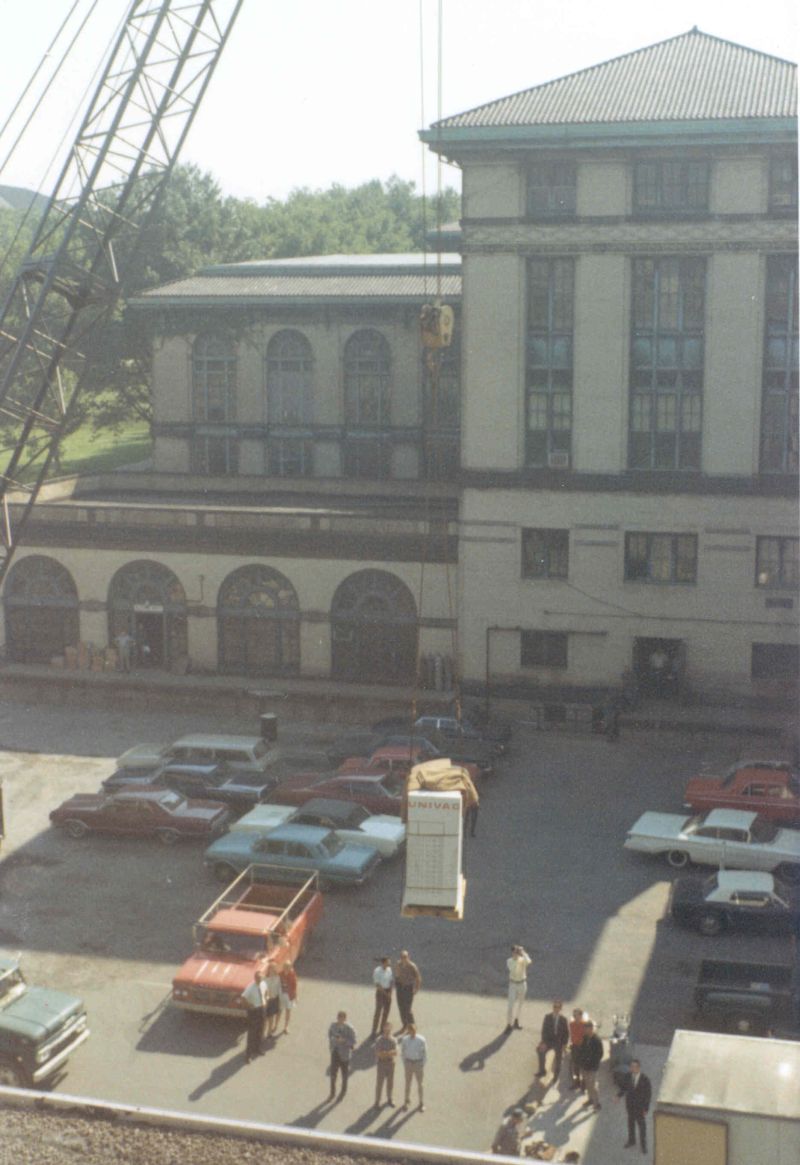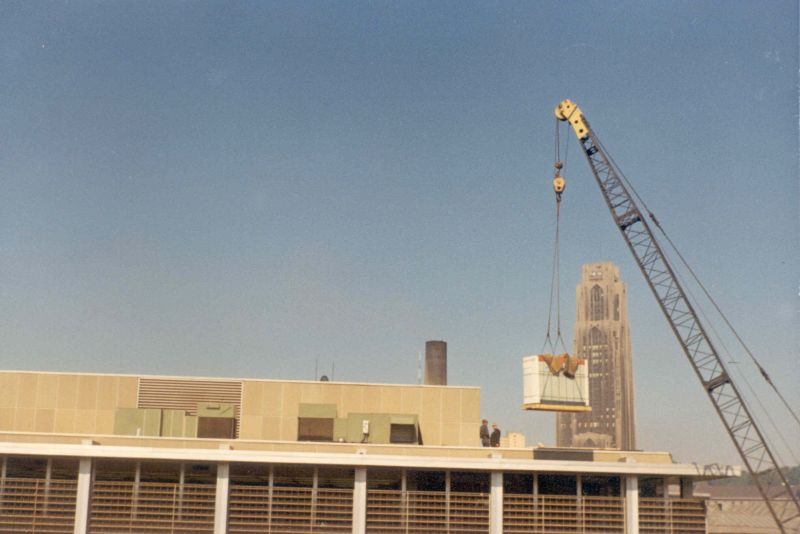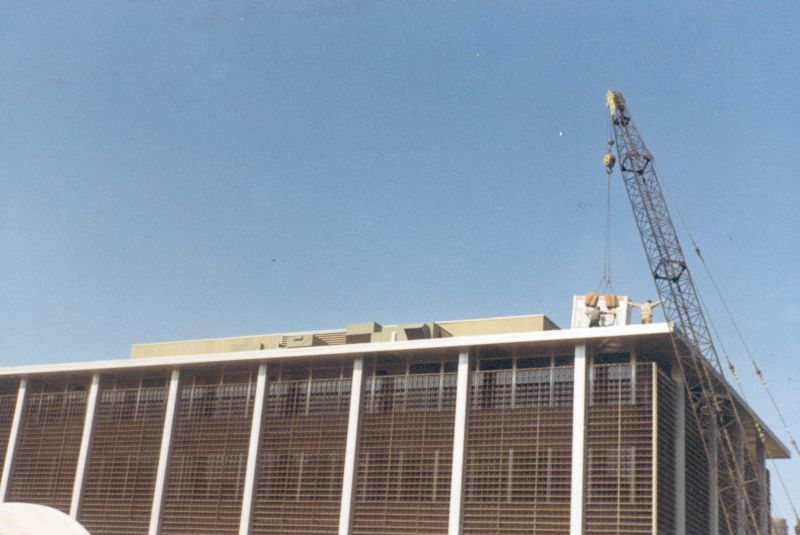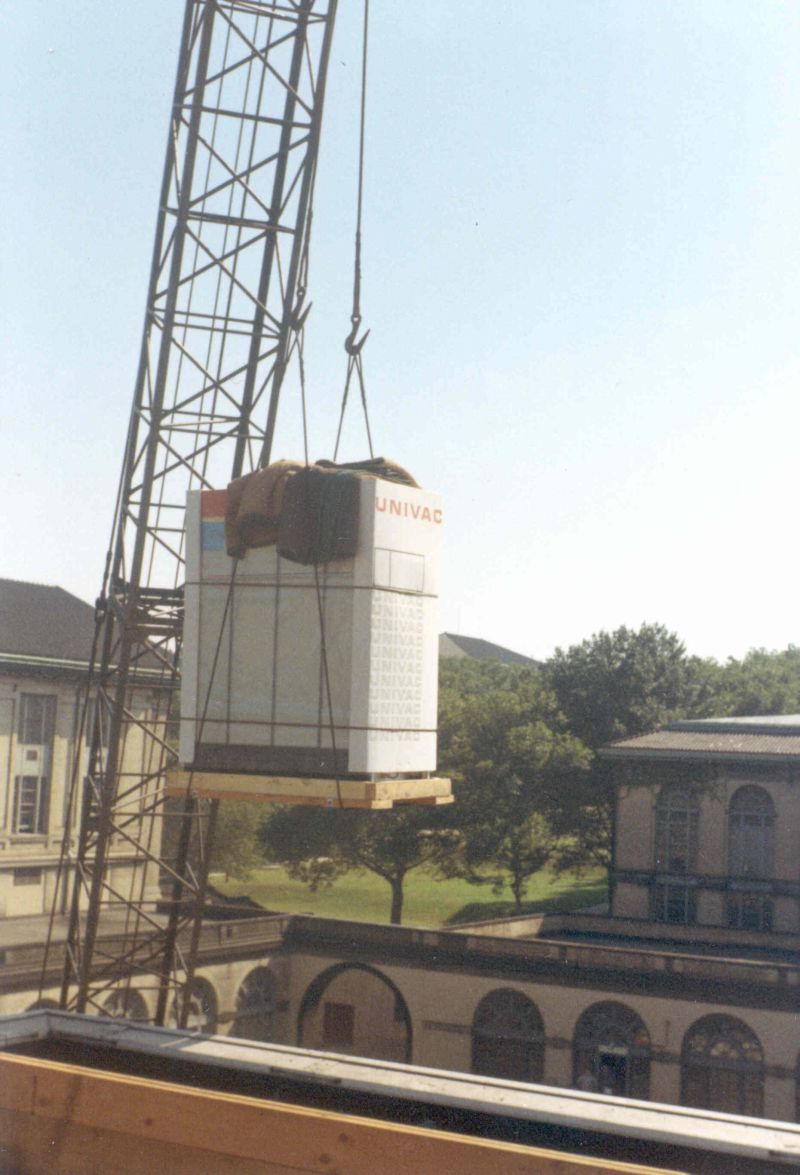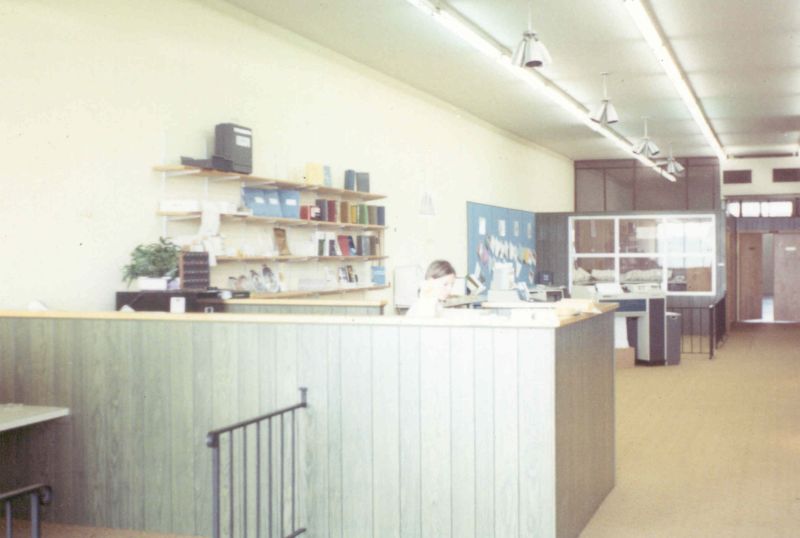Mark,
It was a pleasant surprise to find your photos on the web. I graduated from CMU in 1978 and was an operator/programmer in
the computer center the last few years there. Unfortunately, I
never took any photos. Would it be possible for you to send me higher resolution copies of the three pictures you posted (1108 tape drives, 1108 console, 360 console and computer)?
Many Thanks!
Al |
(I forwarded the email to Cris since took the photos)
Hi Al,
Mark forwarded your message
to me. Yes I took the photos. I believe the ones you want
are the three color ones I took during my first homecoming visit in fall 1976.
I graduated in 1971 after 5 years with a BSEE. I too spent time as a part time operator, mostly on the 1108, from spring 1968 to summer 1970 when I got a job as a lab tech with the Computer Science Department's engineering lab. I figure that as an operator, over those two years I read several hundred thousand punch cards into the 1108's 1004 reader/printer/punch. I had a source of 1/2 inch magnetic tape and still have quite a few spools of it with the "eye" side of the hook-and-eye attachment mechanism used by those UNISERVO VIII drives still spliced onto the leading end of the tape.
I did spend some time with the 360 (not to mention the long gone when you were there G-20's. I still have a masthead printout showing me as the G-20 operator in spring 68. I believe the G-20's were removed that summer. They still existed in private hands during that fall 1976 trip and you can see some photos of them if you are interested by looking at one of the Carl Lefkowitz links on Mark's web site. I still think I had more fun with that machine than any others :-)
I have some questions for you, and I think the other "members" of the group might be interested as well.
First, who were the users of the 360 and 1108 during your time. When we were there, the 1108 replaced the G-20's (and the IBM 7040, used mostly by the Physics department, although I had fun with it, learned FORTRAN :-) as the main user machine with the 360 being more used by the Computer Science Department for research projects. What was the mix when you were there?
Secondly, was the Fastrand II still connected to the 1108? Since I left the campus right after we had moved the computers to Wean from the fourth floor of Scaife in June 1971, I honestly don't recall whether the Fastrand II followed. It is not in the photos but the photos don't show a 360 degree view either. (I however had the fun of disassembling the 1108 processor module in Scaife to get it ready to move as it had to be separated into two pieces to fit into the elevator. It had come into Scaife in one piece through a hole in the roof near the northeast corner of Scaife. (I still remember the worried look on the face of the UNIVAC head CE as he occasionally come around behind the processor box to see me gleefully disconnecting cables and even individual wires :-)
Finally, as you left in 1978, were either or both of the machines still there or had they been removed by that time? Someone at the Unisys History group indicated to me that 1976 was a late date for an 1108 to still be in service.
Anyway, so much for my blathering on, attached are the three photos.
73, J. Chris Hausler
JH37 |
The primary user of the 1108 was the physics department. They had a minicomputer of some sort that looked like an RJE station. They were able to submit jobs and make their own listings. The 1108 was the recommend machine for computationally intensive jobs. The 360 was the general workhorse for the non-comp-sci folks. The computer center also ran RSTS on a PDP-11. It was actually one of the PDP-11's that was intended to be the Front End for the 360. The PDP-11s were originally in a redundant configuration, however they never failed. So one was used for RSTS. In a pinch they could reconfigure it to run as the Front End. Finally, the computer center also had a hybrid computer.
The computer science department had a number of DECsystem 10's as their primary computers. They actually held the 360 is extreme distain. I was very surprised to read your account of their involvement with the 360!!!
When I started working at the computer center (1975 or 1976?), the 1108 had no Fastrands, just a drum. Later, (1977?), they got a number of surplus Fastrands from the Federal government, the Census department I think think. For a while they were stored in the penthouse above the freight elevator in Wean Hall. They eventually installed at least one on the 1108. I remember the physics department running test jobs on it. I do not believe that it had been placed into production when I left CMU in 1978. (It may be that they belonged to the physics department.)
When I left in 1978, I believe that the 1108 and 360 were still running. The center had gotten at least one of the DECsystem 20's by then. General computing was moving to the Decsystem 20's. I am not sure when the 1108 and 360 were decommissioned.
After graduation, I got a job locally and did my M.S. part time. I was in the user area one time and the doors to the expansion area were open. I remember seeing the corpse of the 360 laying abandoned in the expansion area. Soon after that the expansion area was finished and became part of the computer science department.
Oh, what I would have given for that front panel!!!
You can share any of this account, but please do not publish my email address.Feel free to make any editorial corrections/changes.
Al
Do you remember Dean Hiller, Pat DiLeonardo, Bill Pringle, Dave King or Darren Price? |
Hi Al,
Thanks for the information! I know that when the 1108 was purchased, it had to satisfy both the physics department's need for intensive computing (which it did well at, a specific and frequent job from the "scanning lab" which took several hours on the 7040 took 12 minutes on the 1108 :-) and as a replacement for the then general computing facility, the G-20's, which ran Algol, the primary language taught at the school. The 1108 had both a good FORTRAN and a good Algol (and in fact you could mix FORTRAN and Algol subroutines in one job. I would write Algol routines which used FORTRAN subroutines from UNIVAC's "Math-pack" and "Stat-pack" libraries.). We ran a number of benchmarks on both the 360 and 1108 and generally the 1108 cleaned the 360 by a wide margin, I believe due to the fast swapping drums (FH432's ?) on it.
When I was there the 1108 always ran EXEC II. UNIVAC like IBM was developing a multitask and even multiprocessor OS called EXEC 8 but it was having the same problems that IBM was having with TSS. It was my understanding that the school got the 360/67 either free or for cheap because the CS department was going to help with the development and testing of TSS.
While working as an operator I was briefly involved with this effort as
a "trial user". To put it bluntly, it was pathetic.
I think UNIVAC had a similar deal with CASE as I saw an 1108 installation there with two processors and four memory cabinets (CMU just had one of each). It was my understanding that with all these problems, UNIVAC hired an outside firm to develop a quick and dirty OS for the machine until they got "8" working. This was EXEC II, just a batch system with spooling.
From what you are telling me it would appear that it was still running
that when you were there. EXEC II was capable of using RJE stations. One remote customer had a 1004 on a 120 CPS modem and there was a DCT-100 (a bizarre beast) over in the basement of Hammerschlag Hall in the Hybrid Computer room for a while as well. Both these units could read cards and print. Do you know of any other OS's run on the 1108?
When the school first got the 360/67 in fall 1966, there was no real OS for it and briefly it ran things called BOS, TOS and DOS (the B for "basic", the T for "tape" and, of course, the D for "disk"). It came with a number of 2311 disk pack drives which had a pack capacity of about 7 MB. Within a year these were replaced with 2314's which had a pack capacity of about 25 MB. What was the disk component of the 360 when you were there? By this time as well, they were running OS/MFT with HASP when they weren't trying to test TSS. I always heard that Algol 68 which tried to run on the 360 (I never got it to work and gave up quickly) but mostly failed would thus have made the 360 a difficult choice as a general computer for a school so steeped in Algol but maybe by your time the "Algol forces" had dissipated. Of course the PDP-10 became a darling of CS departments all over the country and had many neat languages on it (still have my SNOBOL 4 manual :-)
You are correct, the first PDP-10, a KA10, arrived after the G-20's were removed (occupied the same site in the southwest corner of the forth floor of Scaife) and very quickly, the CS department dropped much effort on the 360 (although not all) and went to the 10. A couple years later they got a second stripped down KA10 about the same time that the ARPANET IMP showed up (I remember it's arrival, in a shielded cabinet with lifting bolts. Sure looked tough next to the PDP-10 cabinets). I am assuming that the two KA10's shown in that photo on Mark's site (the one with the guy in the yellow sweater, John Godfrey, on top of the desk in the CS department computer room also taken during that 1976 visit) were those two units.
I never heard of a PDP-11 as a front end for a 360. Tell me more. I do know that one of the later PDP-10's (KL10?) used a PDP-11 as a console. Within DEC there was almost a war over this or so I've heard. The 10 folks couldn't understand why anyone would put a wart on the front of their beautiful machine and the 11 folks couldn't understand why anyone needed to put such a piece of junk behind their baby :-) I attended the 1983 DECUS in St. Louis just after DEC had announced the termination of the PDP-10 line and the mood was dark and ugly :-) The next time I was at CMU was in the early 80's, 82 or 83, for homecoming, I recall seeing such a machine there. It was in the then glassed in area you faced when you got off the elevators on the third floor of Wean. I believe the 1108 and 360 were both gone by then but am not sure. When I was there for that earlier trip in 1976 that area had housed the C.mmp, one of Gordon Bell's creations I think, and of course the 1108 and 360 as shown in those photos was in the area to the left of that. It was during that 1976 trip that I picked a couple of IBM datacells which I still have out of a trash bin in the then still unfinished area off the third floor under the plaza in front of Hammerschlag. The Datacell drive had been removed from the 360 before I left in 1971. It was a bigger failure than the RCA RACE on the G-20's.
The name Dean Hiller rings a bell but I cannot put a face to it and I have no memory of the others.
You mention a hybrid
computer. What was this? When we were there the EE
department had a hybrid lab which consisted of a
EAI 680 connected with a PDP-9. I was under the impression,
however, that this was decommissioned by the time I left. Although I tried to get access to the 680 there were never enough patch panels to go around and so my "career" as an analog computer programmer never got off the ground. I did however use the PDP-9 frequently (mostly FOCAL language) and still have a DECTAPE from it.
Oh yes, would I love to have a 360 (or an 1108 or a 7040) front panel!!! About 25 years ago I started collecting front panels.
I was once chasing a 7040 panel but that effort failed. I do have
a number of minicomputer panels from the mid 60's to the late 70's and one "midicomputer", a 24 bit machine which I actually installed in 1974 for a customer in Minneapolis
and replaced in 1993. Four of them are shown in that photo of me
in a Santa hat on Mark's page. Clockwise from upper left, Data General Nova 2 (tall chassis), GE-PAC 4010 (the "midi"), Data General Nova 1200 (short chassis) and
DEC PDP-11/70. These are all machines I actually used. My
collection currently consists of: PDP-8/S (have almost the entire machine), PDP-8/L, PDP-11/05, PDP-11/20, PDP-11/34, PDP-11/70, TI-990, Modcomp II, DG Nova 1200 (both short and tall chassis units), DG Nova 2 (tall chassis), DG Nova 3, DG Eclipse S200, DG Eclipse S250 and Honeywell (3C) DDP-516. Unfortunately, however, no "mainframes" and it has been over a decade since I acquired my most recent one. So the "well" seems to have dried up.
Interesting story about the surplus Fastrands. Computer stuff goes obsolete in such a short time. For an employer I once bought a DEC RP04 (80 MB) pack drive and an entire PDP-11/44 system with RLO2 disks and TS11 tape drive both for less than $1000.00 in the late 1980's. They both served me well.
73, J. Chris Hausler |
Chris,
You have an amazing memory!!!
We were still running Exec
II on the 1108. We had a boat-load of Calcomp disks on the 360; not
sure of the model numbers. Plus we added 3 dual IBM 3330 disks
when I was there.
The 360 had 256K of high
speed core and an amazing 4MB of extended core. The extended core
consisted of four 1mb boxes. Each box was about 6 feet wide, 5
feet high, and 2 feet deep. I always think about that when I look
at my 4GB USB memory stick.
I do not know much of the
details about the 360 front end. It handled all of the terminal
(teletype) traffic for the 360. It consisted of two
PDP-11's. Model 45's I think. I believe that all the I/O
was on a Unibus switch. The two processors have shared memory
between them. As I said, the original intent was that the
if one processor failed the other would take over. But they never
failed. So one was dedicated to the front end function; the other
ran RSTS. I believe that the FE processor handled the
terminal traffic for the RSTS processor also. (The communicated through
the shared memory). Aome how the whole thing was connected
to the 360's multiplexer channel and looked like a terminal controller.
Was the 1108/360 network in
place when you were there? It was a bi-sync network that allowed
the machines to use each other's printers and card readers, plus the
360 could submit batch jobs to the 1108.
Al
P.S. When I worked at the
computer center, the old timers would pass on the "tribal
history". One of the stories was about this guy who split the
1108 into two pieces to move it from Scaife Hall to Science Hall.
It is an honor to "talk" to that legendary man. |
Hi Al,
Gee, I didn't know that by the time you attended CMU, the folks at the comp center considered that I was a “legendary man” :-)
I do recall seeing those large extended 360 core boxes when I was there on that trip in 1976. I recall that they were not IBM boxes, but I don't recall the manufacturer. Yes, I've always said that the story of computing is really the story of memory technology as after some initial experimentation with alternative processor architectures, things pretty much settled down by the mid 1950's and advances in that area since have been more a matter of evolution than revolution. But, there's a terabyte USB drive sitting next to me as I write this, one I've had for several years, and it boggles the mind.
Your story about the 360 PDP-11 based terminal front end is interesting. It may explain something which has always puzzled me about that photo on Mark's site of me standing in front of my modem rack. In addition to designing the control logic for and building the modem chassis, I also put together that rack and the power supplies on the back of it into which they were mounted. However, when I left in 1971, the panels below the modem chassis were just blank aluminum panels.
Someone had replaced them with all those plastic DECTAPE racks. I
always wondered why. Likely by 1976 my modems were connected to that PDP-11 front end and thus the convenient DECTAPES. I know DEC had it pretty well together with serial asynchronous I/O. I made great use of their Unibus DZ11 16 channel serial cards which which worked very well.
It has always been my opinion that IBM never really understood serial
asynchronous I/O. The RJE system which was on the 360 under OS/MFT (or maybe it was HASP which was providing it, I don't know) when I was there in the late 60's was
pathetic. IBM always seemed focused, even much later, on high end
synchronous I/O to “smart terminals” like their 2780 and 3270 devices. As recently as ten years ago when I needed to connect serially to an IBM mainframe from one of the computer systems I was developing, to it I had to look like one of those devices. Fortunately there was a company not far from Pittsburgh I believe named “Black Box” which had a number of conversion boxes where you could “talk”
to the box with a standard serial asynchronous link and it would
emulate to the IBM one of those “smart” devices. I made great use of them (not to mention many of their other products like Ethernet network switches).
No, I am not aware that there was an 1108/360 network in place when I was there. I do know that even with the two UNIVAC 1004's and that UNIVAC high speed printer which I think ran about 1000 LPM, with the typical job queues running on the 1108 at that time (student jobs, i.e. compile, load, crash ;-) that the 1108 job queue could go idle but all three printers would continue unloading the spool for ten to fifteen minutes or more and so when any of the three printers and particularly the high speed printer (a very marginal device) was down, the remaining printers couldn't always
keep up with the processor in any reasonable way. The four tape
drives on the 1108 were of course 7 track. The 360 also had four tape drives when I was there (addresses 0C0 to 0C3 :-) and although drives 1-3 were 9 track, drive 0 was 7 track and so could read and write tapes for the 1108. There was a program written for the 360 (and my memory has it that it was written by Athena group member Dave Rodgers) which would read 1108 output spool tapes so to use the 360's printer when one (or more) of the 1108 printers was down. I needed that program one night and could not find the thin deck (the program itself was on the 360 disks, the card deck just called it out). The next day I got the deck and made a number of copies of it so if I ever needed it again and couldn't find the “official” copy I had some spares in my locker in Scaife. Well, when I left CMU in summer 1971 I just cleaned out my various lockers around the campus into boxes.
I know somewhere around here on the “pile” I still have one
or two of those decks :-) I've seen them at least once in the last half dozen years or so.
The G-20's had a home-brew sixteen channel dial-in terminal interface with an RJE and some other features which was quite advanced for its time. When the G-20's were replaced by the 1108, this was lost but there was an effort to use a PDP-8 as a terminal front end for the 1108. It never worked very well and I do not recall why. I heard rumors of hardware
problems but really have no information. It was taken out of
service long before I left. I believe that PDP-8 remained with the comp center however and I recall on the 1976 trip seeing a PDP-8 way in the back of the computer room. Do you recall it and what was being done with it? There were rumors that the PDP-8 which had been Gordon Bell's over in HH53 (photo of me in 1966 or early 67 playing with it on Mark's site) was eventually used to develop a small time sharing system called something like TSS/8 but I don't know if it or even Bell's 8 as well migrated to the computer center. Did they ever put dial-in lines on the 1108, possibly by connecting it to the PDP-11 as well?
You haven't mentioned what course of study you were taking at CMU. I ask this because I have another question not directly related to the comp center itself. The period you were there, 1975 to 1978 corresponds to a period in time I call
the “big bang” of microprocessor technology. It was
in that period that the first major 8 bit microprocessors from
a number of vendors came out. Yes there were some micros before
that but their penetration was limited. The three major ones I saw which all arrived during that time were the Intel 8080, the Motorola 6800 and the MOS Technology 6502. There were others, the Fairchild F8 (one I briefly looked at), the RCA 1802 and others but to the hobby computer market those first three seemed to be the most widespread. I know after studying the subject for about a year (at that time for work I was writing code for Data General 16 bit minis and continued doing that for several years later and then just jumped to DEC PDP-11's about 1981) I jumped in with both feet as a hobbyist in early 1977 selecting the 6800. Anyway, I'm wondering what impact this sudden arrival of all these microprocessors had at CMU, particularly relative to both the CS
and EE departments. Do you recall anything? I would doubt
it had any immediate impact at the comp center, but did it?
73, J. Chris Hausler |
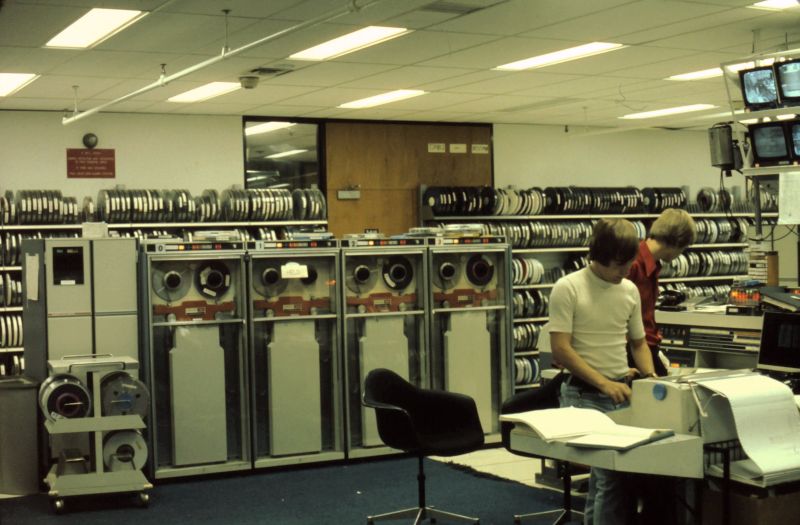

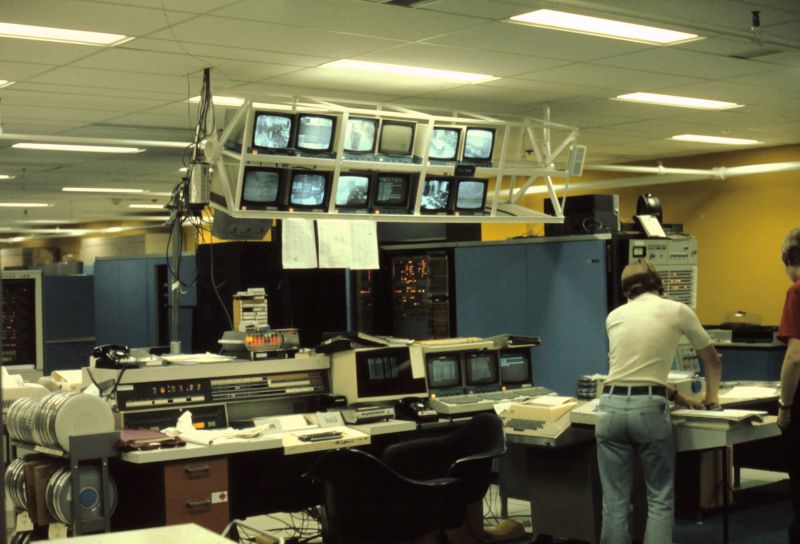

 mcjones.org>
mcjones.org> Then in 2014, I got this email from the above mentioned F.R.A. Hopgood:
Then in 2014, I got this email from the above mentioned F.R.A. Hopgood:
